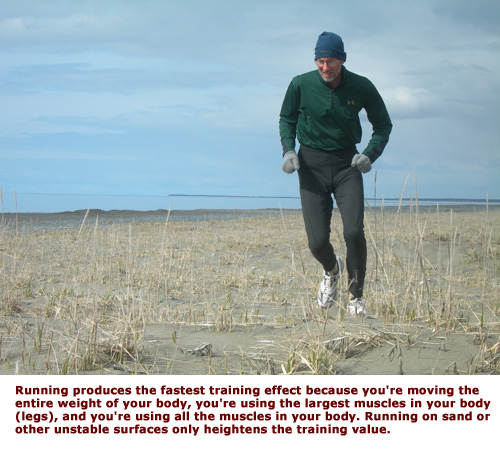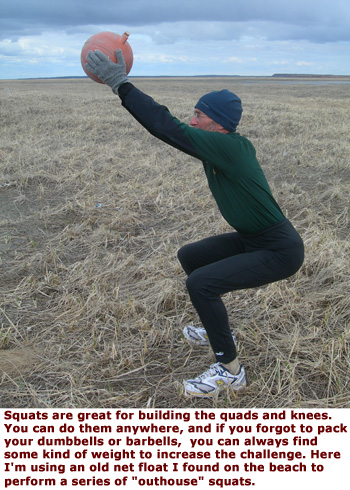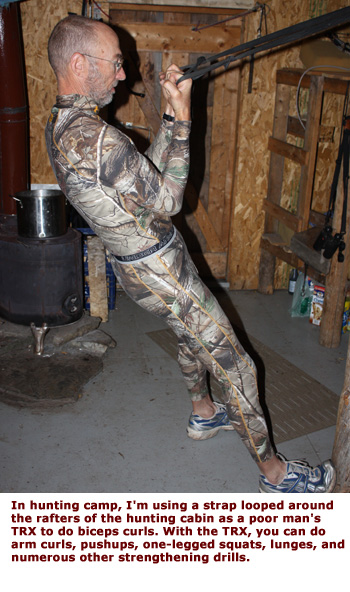Discuss this Article
FOR MOUNTAIN HUNTING, FITNESS may be your most valuable
hunting tool. Let's face it, big game animals are no respecter of persons. They
live in the toughest places on the planet, and you not only have to reach them
but also function at a high level when you get there - day after day. Physical
endurance is your friend. Here's how you get it.
Essentially you can gauge the value of
your training on heart rate. To gain cardio fitness you have to raise your
heart rate to a prescribed training level. The commonly accepted formula is
220-your age x .80-.90. For me the formula would be 220 – 66 = 154 x .85 = 131.
So I try to do most of my training at a heart rate of at least 131.  To learn
more and to quickly calculate your training heart rate, Google "training heart
rate."
To learn
more and to quickly calculate your training heart rate, Google "training heart
rate."
The larger the muscles you use, the faster you will achieve
maximum training effect. Here are some excellent cardio exercises, ranked
roughly by their training value.
Running. This is No. 1 because you must push
all your weight forward with the largest muscles in your body - legs - and you
use all your muscles - legs, core, shoulders, arms. If you're overweight or out
of shape, start by walking, and then progress to jogging and running as you get
in shape. Other great cardio builders are the Stairmaster, NordicTrack,
elliptical, treadmill, and other machines that rely on the legs while bringing
the entire body into play. Work up to a minimum of an hour a day, four to five
times per week.
Also, incorporate specificity training - exercise that
closely mimics your end activity, namely hiking. If you live near hills, do a
couple of hard hikes every week, starting with a 20-pound pack and working up
to 40 or 50 pounds. If you live in flat country, climb stairs. I have spent
hours backpacking the stairs at a local school football stadium.
Cycling. Biking doesn't give the quick cardio
returns of running because you (probably) cannot hit your training heart rate
as quickly. That's because you're essentially using only your legs, and the
bike seat supports most of your weight.
At the same time, on a bike you can push yourself to the
point of exhaustion without the pounding and pain you might suffer from
running. Personally, I can ride a bike to exhaustion (three hours or longer),
and suffer no residual effects, whereas running at that exertion level would
lay me up for two or three days.
When possible, ride on the roads. If that's not possible,
hop on a stationary bike. Or get a trainer for your bike, and ride while you're
watching TV or training DVD's.
Swimming. Building cardio endurance by
swimming can take even longer than by running and biking because the water
supports your weight and you recruit smaller muscles. You have to go all-out to
reach the same heart rate you would achieve easily in running.
Still, I strongly advocate swimming for mountain hunting. An
hour of hard swimming gives you a good cardio effect, and it gives you a solid
upper-body workout. Most people who do nothing but run or bike have weak upper
bodies.
Swimming - and water jogging - work wonders if you're
injured or badly out of shape. While preparing for the Boston Marathon, a
friend of mine hurt his Achilles tendon and couldn't run. So the last two
months before the race he jogged in the pool (up to two hours per session!) to
stay in shape. Without the impact of running on solid ground, his Achilles
healed, and he ran Boston in 3:30.
While cardio fitness builds a strong
engine, muscular fitness builds a strong chassis. The buzz phrase these days is
core fitness, but for good reason - a strong core supports the entire body. If
your core melts down, the whole body goes with it. You see this in long races
as runners start to slump and lose their posture. At that point, they're toast.
Think how much quicker it will happen in the mountains as you carry a bow and
daypack and fight your way up steep slopes.
To keep going hard all day, build a strong core and
musculature. I suggest you do a good core/weight session at least a couple of
times each week. The following exercises are a good starting point.
* A strong cylinder. Your abdominal cylinder supports
the rest of your body. Build it with situps or stomach crunches. Do as many as
you can. Then do some backups to strengthen your back. Lie flat on your
stomach, arms and legs fully extended, and raise your arms and legs off the
floor. If you can't do this, alternately raise your arms and legs. Back curls
on a physio ball are also good.
* Weight training. Start with good old pushups and
pull-ups. You can do them anywhere, and they build strong arms and shoulders
just as they did 50 years ago in my school PE classes. For the legs do squats
and lunges. Again, you can do these anywhere, and you can easily add weight to
increase demand. In one hunting camp, I used a propane cylinder in place of a
barbell while doing squats and lunges.
 If you have access to a gym with free weights or machines,
do leg presses (squats), lunges, toe raises, knee extensions, bench presses,
biceps curls, and triceps extensions. This regimen will strengthen most of the
muscles you use in hunting.
If you have access to a gym with free weights or machines,
do leg presses (squats), lunges, toe raises, knee extensions, bench presses,
biceps curls, and triceps extensions. This regimen will strengthen most of the
muscles you use in hunting.
With newer approaches like the TRX, a strap attached to the
wall or ceiling, you can do pull-ups, pushups, squats, lunges, and other
exercises. I've even done the TRX routine in hunting camp, using a 20-foot
length of nylon webbing as a poor man's TRX. Kettlebell training will give you
a great workout, too.
During a long hunt, you wouldn't carry a load
of rocks in your pack just for fun, so why carry a load of fat? Not only does
fat indicate you're out of shape, but it's also as functional as the rocks. In
short, for aggressive mountain hunting get as lean as possible without
sacrificing strength.
You probably will not lose weight simply by exercising. A
friend of mine works out religiously, but he remains overweight because he eats
too much - and eats fattening junk foods.
To lose weight, or to stay slim, you have to combine
exercise with good eating habits. That doesn't mean you have to go wacko to
stay slim. A little common sense and self-control will do the trick. Several
years ago I weighed 185 pounds, but 20 pounds of that was nothing but a spare
tire around my waist. Tired of packing that around, I vowed to get rid of it.
Combining some eating restraint with exercise, I dropped to
an ideal 165, and I've held that weight ever since with a simple plan: 1) Cut
out the ice cream. As an ice cream-aholic, I had to break the habit (with the
exception of birthdays and an occasional celebratory Coldstone after a great
hunting trip or race). Maybe your weakness is soda. Drink water. Identify your
weakness and go on the wagon. 2) Stick with two helpings. I used to eat until I
could eat no more. Now I hold myself to two reasonable helpings.
That's my simple diet plan - quit eating like a pig (well,
in terms of quantity). In short, you don't have to become a diet fanatic to
maintain an ideal hunting weight. Just cut out the excessive and unneeded
calories (soda, beer, ice cream, rich deserts, pizza, etc.), and eat servings
proportionate to your level of exercise. Follow this simple exercise/diet plan,
and you'll conquer the tallest of mountains and biggest of big game.